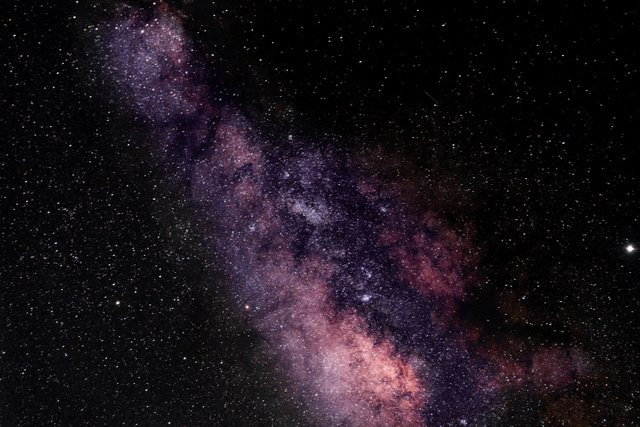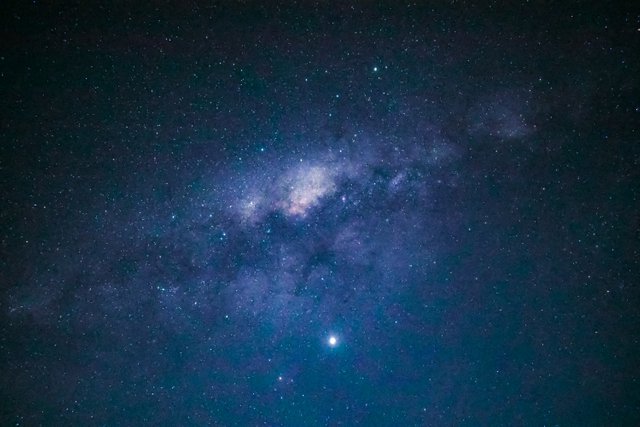Scientists descovered a new hidden structure at our solar neighborhood . [GR/ENG] [Power Up 100%]
Μια επιστημονική ομάδα με επικεφαλής ερευνητές από το Κέντρο Αστροβιολογίας (CAB, CSIC-INTA), σχεδίασε τον πιο λεπτομερή χάρτη μέχρι σήμερα των τεράστιων μπλε αστεριών στην ηλιακή γειτονιά, ανακαλύπτοντας σε αυτήν μια κρυφή δομή, βαπτισμένη ως "spur" του Cepheus. Αυτή η δομή, η οποία εκτείνεται πάνω από το γαλαξιακό επίπεδο που συνδέει τον σπειροειδή βραχίονα του Ωρίoνα με αυτόν του Περσέα, θεωρείται το αποτέλεσμα ενός κυματοειδούς μοτίβου που παράγεται στο δίσκο του Γαλαξία μας.

Τα τεράστια μπλε αστέρια (επίσης γνωστά ως αστέρια OB) έχουν μια ιδιαιτερότητα που τα καθιστά ιδιαίτερα ενδιαφέροντα για τους αστροφυσικούς: Έχουν βραχύβια διάρκεια ζωής μερικών εκατομμυρίων ετών. Έτσι, με τον ίδιο τρόπο που η χρονολόγηση των βράχων αποκαλύπτει το επίπεδο της γεωλογικής δραστηριότητας ενός πλανήτη, η παρουσία των αστεριών OB στον Γαλαξία μας είναι ένας δείκτης δραστηριότητας στον Γαλαξία μας, καθώς αποκαλύπτουν περιοχές σχηματισμού αστεριών. Όπου τα βρίσκουμε, μπορούμε να πούμε ότι ο Γαλαξίας είναι "ζωντανός", καθώς σχηματίζονται νέα αστέρια. Συμβαίνει επίσης ότι αυτά τα αστέρια μικρής διάρκειας δεν έχουν χρόνο να απομακρυνθούν από τις περιοχές όπου γεννιούνται, τους σπειροειδείς βραχίονες, επομένως αποτελούν επίσης εξαιρετικές αναφορές για τη χαρτογράφηση αυτών των γαλαξιακών δομών.
Με αυτόν τον στόχο, μια ομάδα ερευνητών με επικεφαλής το Κέντρο Αστροβιολογίας (CAB, CSIC-INTA) πραγματοποίησε μια εξαντλητική ενημέρωση του καταλόγου ALS (Alma Luminous Stars), του μεγαλύτερου υφιστάμενου καταλόγου τεράστιων αστεριών OB στον γαλαξία μας. Πριν από δύο δεκαετίες, αυτός ο κατάλογος περιέχει σχεδόν 20.000 αντικείμενα. Για μήνες, οι ερευνητές διέσχισαν τα παλιά δεδομένα από κάθε αστέρι με τα δεδομένα που αποκτήθηκαν πρόσφατα με την αποστολή Gaia της ESA, αποκτώντας έναν εντελώς ενημερωμένο κατάλογο. Τα νέα δεδομένα, που δημοσιεύθηκαν πρόσφατα στις Μηνιαίες Ειδοποιήσεις της Βασιλικής Αστρονομικής Εταιρείας (MNRAS), επέτρεψαν στην ομάδα να σχεδιάσει τον πιο λεπτομερή χάρτη των σπειροειδών βραχιόνων του Γαλαξία για πρώτη φορά.
Όπως επισημαίνει ο Michelangelo Pantaleoni González, ερευνητής της CAB και επικεφαλής συγγραφέας της μελέτης, «έχουμε αναθεωρήσει διεξοδικά τον αρχικό κατάλογο, τον ενημερώνουμε και συστηματοποιούμε με σύγχρονα δεδομένα της Gaia. Και παρόλο που αυτός ήταν ο σκοπός της μελέτης, έχοντας ένα τέτοιο ενημερωμένο δείγμα αστεριών μας οδήγησε να ρίξουμε μια ματιά στα δεδομένα για να δούμε ποιες πτυχές του γαλαξιακού μας περιβάλλοντος εκδηλώνονταν πιο ξεκάθαρα. Και εκεί προέκυψε η έκπληξη ».
Ο χάρτης είναι τόσο λεπτομερής που επέτρεψε στην επιστημονική ομάδα να ανακαλύψει κάτι που κανείς δεν έχει δει στο παρελθόν: ένα κλαδί του σπειροειδούς βραχίονα μας (εκείνο του Orion) μήκους περίπου 10.000 ετών φωτός που εκτείνεται προς τα έξω προς την κατεύθυνση του επόμενου βραχίονα (αυτή του Περσέα), επίσης υψώνεται πάνω από το επίπεδο του Γαλαξία. Οι ερευνητές έχουν ονομάσει αυτήν την πρόσφατα ανακαλυφθείσα δομή "το κίνητρο του Cepheus": spur (spur στα αγγλικά) γιατί ονομάζονται αυτό το είδος δομής μεταξύ των βραχιόνων και του Cepheus επειδή είναι ο αστερισμός όπου είναι πιο εμφανής.
Όσον αφορά την προέλευση αυτής της δομής, ο Jesús Maíz Apellániz, ερευνητής της CAB και συν-συγγραφέας της μελέτης, επισημαίνει ότι «είχε προταθεί πρόσφατα ότι υπάρχει κάτι που ονομάζεται Radcliffe wave ως ταλάντωση στην κάθετη κατανομή (όσον αφορά την Γαλαξιακό αεροπλάνο) των αστεριών νέοι γύρω μας. Αυτή η μελέτη παρουσίασε την ταλάντωση ως ένα φαινόμενο σε μία διάσταση και με αυτή τη μελέτη έχουμε δει ότι συμβαίνει σε δύο διαστάσεις. Το Cepheus spur είναι η κορυφή του κυματισμού και η κοιλάδα σχηματίζεται από άλλες περιοχές που σχηματίζουν αστέρια, όπως τα νεφελώματα Orion και Rosette. Αυτό το φαινόμενο είναι γνωστό ως κυματοειδές, δηλαδή, το γαλαξιακό επίπεδο έχει ρυτίδες σαν ένα πανί στο έδαφος χωρίς τέντωμα και αυτή είναι η καλύτερη απόδειξη της ύπαρξής του στο ηλιακό περιβάλλον ».
«Είναι ενδιαφέρον να σημειωθεί ότι ο τεράστιος αριθμός δεδομένων που αποκτήθηκαν με την αποστολή Gaia και τη χρήση στατιστικών εργαλείων μας επέτρεψε να εξαγάγουμε ενδιαφέροντα γενικά συμπεράσματα για το περιβάλλον μας, όπως ενδείξεις για τη στρέβλωση του γαλαξία μας και τις κυματοειδείς δίσκους , τα οποία πιθανώς είναι λείψανα της σπασμένης εξέλιξης του Γαλαξία », καταλήγει το Πανταλέων.
A scientific team led by researchers from the Center for Astrobiology (CAB, CSIC-INTA), has drawn the most detailed map to date of massive blue stars in the solar neighborhood, discovering in it a hidden structure, baptized as the Cepheus spur. This structure, which extends over the Galactic plane connecting the spiral arm of Orion with that of Perseus, is considered the result of a corrugation pattern produced in the disk of our Galaxy.
Massive blue stars (also known as OB stars) have a peculiarity that makes them especially interesting to astrophysicists: They have a short-lived life span of a few million years. Thus, in the same way that the dating of rocks reveals the level of geological activity of a planet, the presence of OB stars in the Milky Way is an indicator of activity in our Galaxy, since they reveal regions of star formation. Where we find them we can say that the Galaxy is "alive", as new stars are forming. It also happens that these short-lived stars do not have time to move away from the areas where they are born, the spiral arms, so they are also excellent references to map those Galactic structures.
With this objective, a team of researchers led by the Center for Astrobiology (CAB, CSIC-INTA) has carried out an exhaustive update of the ALS catalog (of Alma Luminous Stars), the largest existing catalog of massive OB stars in our galaxy. Compiled two decades ago, this catalog contains almost 20,000 objects. For months, researchers have crossed the old data from each star with the data recently obtained with ESA's Gaia mission, obtaining a completely up-to-date catalog. The new data, recently published in the Monthly Notices of the Royal Astronomical Society (MNRAS), has allowed the team to draw the most detailed map of the spiral arms of the Milky Way for the first time.
As Michelangelo Pantaleoni González, CAB researcher and lead author of the study, points out, “we have thoroughly reviewed the original catalog, updating and systematizing it with modern Gaia data. And although this was the purpose of the study, having such an up-to-date sample of stars led us to take a look at the data to see what aspects of our Galactic environment were manifesting most clearly. And there the surprise arose ”.
The map is so detailed that it has allowed the scientific team to discover something that no one has seen before: a branch of our spiral arm (that of Orion) about 10,000 light-years in length that extends outward in the direction of the next arm ( that of Perseus), also rising above the plane of the Galaxy. Researchers have named this newly discovered structure "the spur of Cepheus": spur (spur in English) because it is how they are called this type of structure between arms and Cepheus because it is the constellation where it is most prominent.
Regarding the origin of this structure, Jesús Maíz Apellániz, CAB researcher and co-author of the study, points out that “it had recently been proposed that there is something called a Radcliffe wave as an oscillation in the vertical distribution (with respect to the Galactic plane) of the stars young people from our environment. This study presented the oscillation as a phenomenon in one dimension and with this study we have seen that it occurs in two dimensions. The Cepheus spur is the crest of the ripple and the valley is formed by other star-forming regions such as the Orion and Rosette nebulae. This phenomenon is known as corrugation, that is, the Galactic plane has wrinkles like a cloth laid on the ground without stretching and this is the best demonstration of its existence in the solar environment.
“It is interesting to note that the huge amount of data obtained with the Gaia mission and the use of statistical tools has allowed us to draw interesting general conclusions about our environment, such as indications of the warping of our galaxy and the corrugations of the disk, which are probably relics of the convulsed evolution of the Milky Way ”, concludes Pantaleoni.

Hello dear @aintaa, Put this down in English language. We don't allow other Languages for now.
Is both in greek and English. At the community rules i saw that posts can be at any language.
You want me to keep only eng?
Ok. Keep in English as we do not appreciate other languages for now,.
Sorry> this post is late already for support. Tag me when next you make a new post,please.